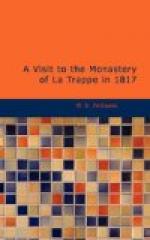From Alencon, we passed the Briante, a small river, at Ville Neuve, where the road begins to skirt the Forest of Moultonue. At Mayenne, the river of that name divides the provinces. The whole of this country is singularly beautiful. I observed vast quantities of buck wheat, which the French call bled noir or sarazin. The country was very much enclosed, producing a great contrast to the vast tracts of land through which I had passed without a single division.
At two leagues from Mayenne we crossed the river Aisne, winding through a beautiful valley, between Martigne and Louverne. On the left the river forms a small lake, surrounded by a wood at the foot of a very long and steep hill.
The town of Mayenne is ancient and irregularly built, the river Mayenne running through it. The ruins of an old wall and some decayed towers remain of the fortifications which were taken by assault, after several bloody attempts, during the siege by the English, in 1424.
At Laval, where I stopped, after again crossing the Mayenne, I entered the province of Bretagne: it is an old dirty town, completely intersected by the river, and has a manufactory for coarse cloths and cottons. The Tete Noire is one of the worst inns I have met with in the country. The department of the Isle-et-Vilaine commences here.
This place is celebrated in the history of the Vendean war by the refuge Madame de Laroche-Jaquelin sought there, after the deplorable defeat of the royalist army at the battle of Mans, where it received its death-blow. The wreck of that army, under M. de Laroche-Jaquelin, were driven from it again on the following day, and from that hour never rallied so as to make any stand against the victorious republicans.
Quitting Laval the day after my arrival, I ascended a long and steep hill, travelled by the side of the forest of Petre, and came to Vitre, where I remained all night for the purpose of visiting the chateau of the celebrated Madame de Sevigne,[4] whose estate has descended to a distant branch of her family, who had the good fortune to save it from destruction during the revolution. The grounds are kept in excellent order. Her picture hangs in the apartment in which she composed her interesting and elegant letters, and every article of furniture carefully preserved is shown to strangers. The distance from Vitre to Rennes is seven leagues, over a road which becomes gradually less and less Interesting.
[Footnote 4: Marie de Rabutin, Marchioness de Sevigne, was the daughter of the Baron de Chantal, and born in 1626: she espoused at the age of eighteen the Marquis de Sevigne, who fell in a duel in 1651, leaving her with one son and a daughter, to whose education she paid strict attention: the daughter married in 1669 the Count de Grignan, Commandant in Provence, and it was on a visit to her that the Marchioness caught a fever and died in 1696. Her son Charles, Marquis de Sevigne, was one of the admirers of Ninon de L’Enclos, and had a dispute with Madame Dacier respecting the sense of a passage in Horace. He died in 1713. (Moreri.)]




